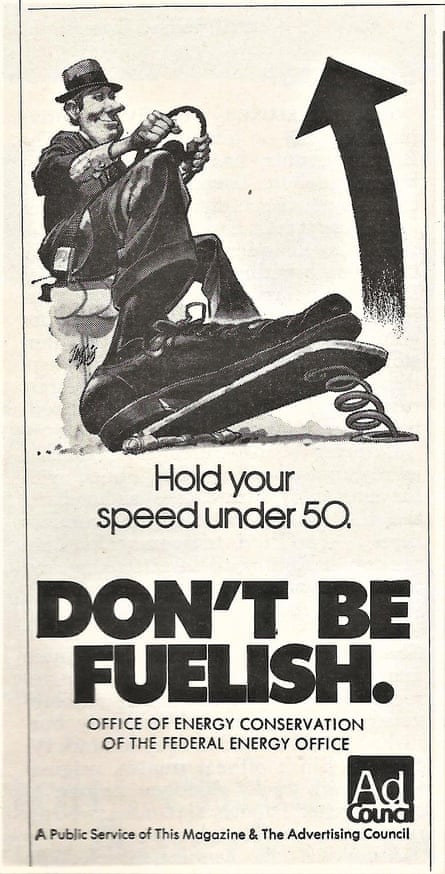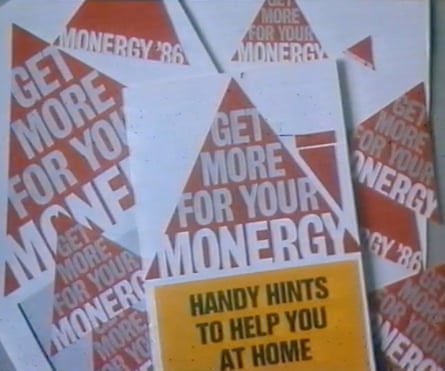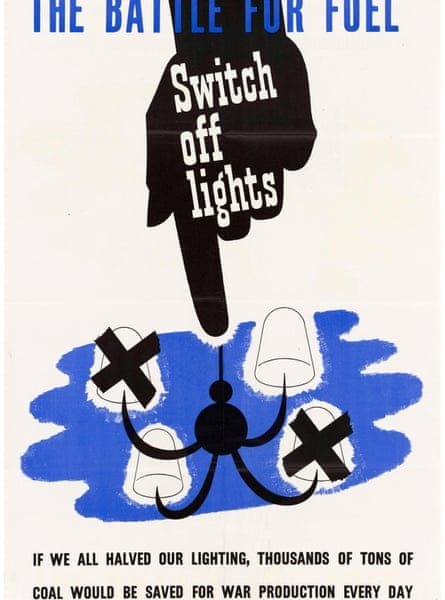Calls have been growing for the UK government to launch an official campaign to encourage people to reduce their energy use this winter in the face of soaring bills and concerns about power cuts.
Some senior Conservatives have been resistant to the idea on the grounds that it would appear to be the actions of a “nanny state” but there may yet be a rethink.
If and when that happens, it would not be the first time the government had funded a drive to reduce energy use. During the second world war, patriotism was at the heart of a campaign to conserve coal; adverts and stickers in the 1970s encouraged us to “Save It”; and during the 1980s, Margaret Thatcher’s government wanted us all to be thinking about “Monergy”.
In the absence of a full-scale official campaign, there has been a plethora of advice from other sources: broadcasters have squeezed every last drop of information from Martin Lewis, elevating him to near sainthood.
But not all interventions have been welcomed. At the start of this year, Ovo Energy apologised after a division of the company encouraged customers to keep warm by “doing a few star jumps”.
With the lack of a large-scale push by the government, and some of the current information being touted of a dubious standard, what do energy experts think about the advice offered up by past campaigns?
The second world war
The energy-saving campaigns during the second world war typically had a clear and simple message: use less – the war comes first.
In the Battle for Fuel campaign, we were told to switch off lights and close windows as “draughts eat coal”. These messages would stick around in later pushes to conserve energy, and still feature in campaigns around the world today.
 View image in fullscreenA poster from the Battle for Fuel campaign during the second world war. Photograph: incamerastock/Alamy
View image in fullscreenA poster from the Battle for Fuel campaign during the second world war. Photograph: incamerastock/Alamy
Joanna O’Loan, a knowledge manager at the Energy Saving Trust, says: “LED and other low-energy lightbulbs have achieved a huge reduction in energy used for lighting our homes. However, it’s still good advice – turning off LED lights in the typical home when not in use could save you about £9 a year.”
Some of the wartime advice provided very specific details, with posters claiming the benefits of lagging pipes and tanks could “save as much as one ton of fuel a year” and giving detailed instructions on how to re-washer taps to stop them leaking.
During the early 1940s, cinemagoers were even shown a naked man encouraging them to run just “five inches of warm water” in the bath, with his ankle fashioned into a makeshift ruler to ensure accurate filling.
O’Loan says most heating systems work differently now but that if you do have an old hot water cylinder with less than 25mm thick foam insulation, it is a good idea to consider fitting an 80mm insulation jacket, and that this could save you about £70 a year on your gas bill.
Lagging your hot water pipes is still a good idea, too. The Energy Saving Trust reckons this will achieve savings of about £9 a year, with the insulating collars typically about £1.50 a metre.
It is worth staying on top of any leaks, too. A dripping tap could waste an estimated 5,500 litres a year, costing you an extra £14 on average.
Limiting how much hot water you put in your bath remains a good idea but to make bigger savings, showers beat baths – as long as you limit how long you are in there. O’Loan says: “If you switch out a 70-litre bath for a four-minute shower once a week for a year, you could save £9 per person.”
1970s: the Save It campaign
 View image in fullscreenThe DIY presenter Barry Bucknell in a Save It UK public information film in 1976. Photograph: YouTube
View image in fullscreenThe DIY presenter Barry Bucknell in a Save It UK public information film in 1976. Photograph: YouTube
An official-looking red stamp logo bearing the slogan Save It and the message “Energy sense is common sense” was at the centre of a multimillion-pound campaign in the 1970s. Ministers would later claim it brought the country savings of £330m.
A 1976 public information film lent on the celebrity of Delia Smith, her knitted tank top adorned with a Save It badge. With the in-laws coming for dinner, she has to cook something “a bit special” – but that doesn’t mean she can’t be economical.
In general, your hob and microwave will use less energy than turning on your ovenThe Energy Saving Trust’s Joanna O’Loan
Packing the oven full of food, including “Dad’s favourite”, bread and butter pudding, plus spiced chicken, rice, and leek and potato soup, she tells the viewer “cooking everything together really does save fuel, and nowadays I think a good cook is an economical cook”.
O’Loan agrees with Delia. “In general, your hob and microwave will use less energy than turning on your oven – but you might find it a bit tricky to cook that something ‘a bit special’ using a microwave and hob alone. Delia’s right: if your oven is going to be on anyway, cook everything together to save energy. Batch-cooking in an oven and heating up leftovers later in the week in your microwave can be economical.”
Barry Bucknell, a TV presenter who popularised DIY, was another name recruited to front a Save It public information film, which advised people to make sure their central heating system was serviced regularly and working efficiently.
 View image in fullscreenArtwork from the Don’t Be Fuelish campaign in the US in 1975. Photograph: Don’t Be Fuelish PSA
View image in fullscreenArtwork from the Don’t Be Fuelish campaign in the US in 1975. Photograph: Don’t Be Fuelish PSA
The US’s Don’t Be Fuelish campaign
The energy crises of the 1970s led to the US launching a campaign with the slogan Don’t Be Fuelish.
During the mid-1970s an informative booklet was published with a foreword from the president, Gerald Ford: “… As one of my first requests as president, I ask each of you to apply our most abundant natural resource – American ingenuity – toward including energy conservation in your life.”
The booklet was filled with many suggestions that are still promoted today. They included insulating your attic and using energy-intensive appliances at off-peak hours, plus some less talked about ideas: the importance of keeping lamps and lighting clean as “dirt absorbs light”, and that when it came to decorating, “light colours for walls, rugs, draperies and upholstery reduce the amount of artificial lighting required”.
One prominent part of the campaign focused on cars. It promoted the benefits of lift-sharing as well as holding your speed when driving, although the speed people were told they should aim for was inconsistent, with print adverts extolling the benefits of keeping under 50mph but a short film fronted by The Rockford Files star James Garner stating: “Please drive under 55.”
Dr Steven Fawkes is a specialist in energy efficiency and says “you need to take into account road conditions” but that cars get the best miles per gallon “at somewhere in the range 40-60mph”. He adds: “It isn’t only speed you should think about – rapid acceleration and lots of stop-start increases consumption. Smooth driving can save significant quantities of fuel.”
When Jimmy Carter became US president in 1977, he proved his green credentials by installing solar panels on the roof of the White House. In a television address, wearing a cardigan in front of an open fire, he encouraged the public to do their bit by setting their thermostat to “65 degrees [fahrenheit] in the daytime and 55 degrees at night”. He reportedly also played his part by going around unplugging TV sets and turning off air-conditioning units.
The exact temperature your home should be set to will vary depending on personal preference and the nature of your home, says Fawkes, adding that “air temperature can typically be several degrees lower in a very well-insulated house than in a normal house”.
Incidentally, it is worth noting that the UK actually got there first when it came to that slogan: second world war energy-saving posters carried the message “Don’t be Fuel-ish”.
 View image in fullscreenMonergy was the buzzword for an energy-saving campaign in 1986. Photograph: YouTube
View image in fullscreenMonergy was the buzzword for an energy-saving campaign in 1986. Photograph: YouTube
1980s: the Get More For Your Monergy campaign
Monergy, described at the time as memorable but “not the most elegant word ever coined”, was the buzzword of a UK campaign in 1986, which was known as “energy efficiency year”.
The campaign aimed to stop the “scandalous waste of money and energy in which Britain indulges at the moment”, said the then energy secretary, Peter Walker.
A series of colourful short films, featuring a family of pigs, suggested cavity wall insulation could save you “about £4 a week every winter”, and “draught-stripping” (draught-proofing) could save “about £1 a week”.
The Energy Saving Trust says most modern homes are built with insulation already installed but if you have not already got cavity wall insulation, it could save the typical household about £395 a year. You can check your home’s energy performance certificate (if you have one) to see if you have it fitted.
If you do decide to get it installed, the trust says it is important to do your homework on a reputable installer. Check it is signed up to the National Insulation Association, the Cavity Insulation Guarantee Agency or the British Board of Agrément. Experts recommend getting at least three different installers to quote before going ahead, and making sure your insulation is guaranteed for 25 years by CIGA or through an independent insurance-backed guarantee.
The rest of the advice from the family of pigs still stacks up, too, according to O’Loan.
“Draught-stripping is more commonly called draught-proofing these days and can make a significant difference, especially for those of us in older, draughty homes. Draught-proofing your windows and doors could save you about £60 a year on your energy bills and can be done as a DIY job – you can purchase strips, sealant and brushes from any DIY retailer.” However, be careful not to block or seal any intentional ventilation, including extractor fans, grilles or airbricks, wall vents or window trickle vents.
 View image in fullscreenThe Monergy campaign of the 1980s was aimed at stopping the ‘scandalous waste of money and energy in which Britain indulges’. Photograph: YouTube
View image in fullscreenThe Monergy campaign of the 1980s was aimed at stopping the ‘scandalous waste of money and energy in which Britain indulges’. Photograph: YouTube
Do decades of the same advice being repeated to us mean that the public has not been paying attention? Or that sometimes what we are told isn’t going to make as big a difference as public information campaigns make out?
O’Loan says: “We’ve made huge strides in home energy efficiency over the decades, no doubt thanks to some of these campaigns. In 2020, just over half of homes had cavity or solid wall insulation, up from 41% in 2010. Against a backdrop of rising energy costs and the challenges of the climate emergency, it can be difficult to appreciate the improvements made.”
The Energy Saving Trust told us the quoted savings were based on a typical three-bedroom gas-heated semi-detached house in Britain using an average gas price of 10.3p per kilowatt hour and an electricity price of 34p/kWh, and were correct as of October 2022.



